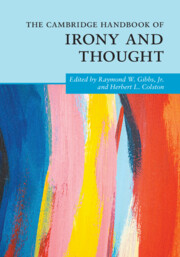Book contents
- The Cambridge Handbook of Irony and Thought
- Cambridge Handbooks in Psychology
- The Cambridge Handbook of Irony and Thought
- Copyright page
- Contents
- Contributors
- Part I Introduction
- Part II The Scope of Irony
- Part III Irony’s Impact
- Part IV Irony in Linguistic Communication
- 8 Constructions in Verbal Irony Production: The Case of Rhetorical Questions
- 9 Tracking the Ironical Eye: Eye Tracking Studies on Irony and Sarcasm
- 10 Inferring Irony Online
- 11 Irony and Thought: Developmental Insights
- 12 Vocal Strategies in Verbal Irony
- 13 Great Expectations and EPIC Fails: A Computational Perspective on Irony and Sarcasm
- Part V Irony, Affect, and Related Figures
- Part VI Irony in Expressive, Nonlinguistic Media
- Index
- References
10 - Inferring Irony Online
from Part IV - Irony in Linguistic Communication
Published online by Cambridge University Press: 20 December 2023
- The Cambridge Handbook of Irony and Thought
- Cambridge Handbooks in Psychology
- The Cambridge Handbook of Irony and Thought
- Copyright page
- Contents
- Contributors
- Part I Introduction
- Part II The Scope of Irony
- Part III Irony’s Impact
- Part IV Irony in Linguistic Communication
- 8 Constructions in Verbal Irony Production: The Case of Rhetorical Questions
- 9 Tracking the Ironical Eye: Eye Tracking Studies on Irony and Sarcasm
- 10 Inferring Irony Online
- 11 Irony and Thought: Developmental Insights
- 12 Vocal Strategies in Verbal Irony
- 13 Great Expectations and EPIC Fails: A Computational Perspective on Irony and Sarcasm
- Part V Irony, Affect, and Related Figures
- Part VI Irony in Expressive, Nonlinguistic Media
- Index
- References
Summary
The versatility of irony is evident in the variety of ways and places in which it is used. This chapter considers some of the complexities of ironic language on the internet (e.g., social media, messaging apps). Yus views irony as being associated with making a reference to some state of affairs that can be criticized or mocked, and which communicates a speaker’s attitudes toward that situation, including others who adopt a similar point of view. He embraces a “relevance theory” perspective to emphasize the prominence of echoic mention as a key source of pragmatic information when determining an ironic speaker’s dissociative attitude. Yus details the range of contextual information that enables successful irony use, even in situations where individuals do not share the same immediate physical space. This information includes widely held encyclopedic background knowledge, speaker-specific encyclopedic knowledge, previous utterances, particular linguistic cues, and information from the current physical setting. These different sources of contextual information are combined in specific ways to enable ironic meaning interpretation when people are not physical co-present (e.g., when posting messages or writing email on the internet).
Keywords
- Type
- Chapter
- Information
- The Cambridge Handbook of Irony and Thought , pp. 160 - 180Publisher: Cambridge University PressPrint publication year: 2023



